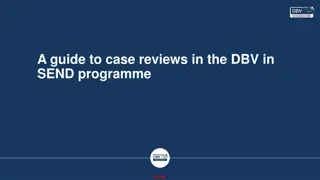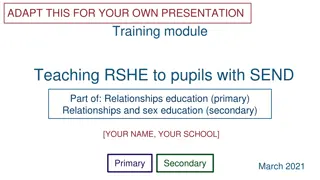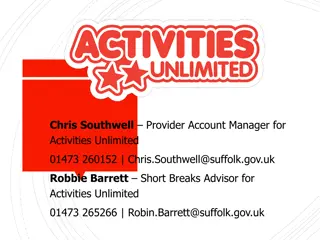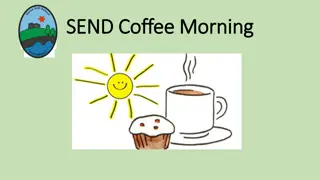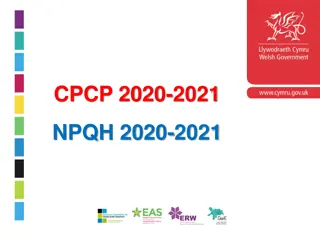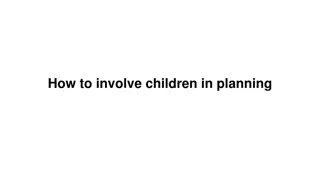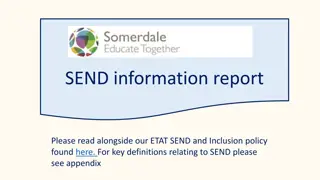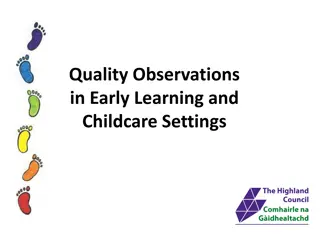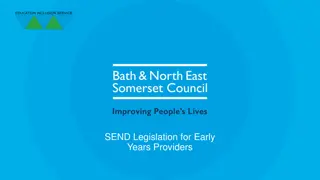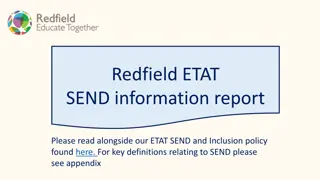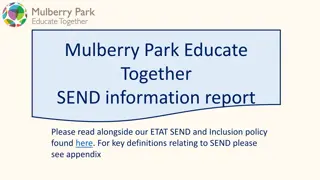Supporting Children with SEND: Evidencing Progress and Planning Strategies
Explore strategies for assessing and evidencing progress in children with SEND, presented by Dr. Ruth Dennis. Topics include the importance of progress grids, identifying additional needs, target setting, and planning for progress. Learn how to utilize progress grids effectively to support children with high-level needs.
Download Presentation

Please find below an Image/Link to download the presentation.
The content on the website is provided AS IS for your information and personal use only. It may not be sold, licensed, or shared on other websites without obtaining consent from the author. Download presentation by click this link. If you encounter any issues during the download, it is possible that the publisher has removed the file from their server.
E N D
Presentation Transcript
Evidencing Progress for Children with SEND Dr Ruth Dennis Principal Educational Psychologist September 2017
Session Overview Why we need Progress Grids Using the Progress Grids to identify children with additional needs Practice using the Progress Grid Planning for progress Practice target setting Review Next Steps
Introductions Introduce yourself to your neighbour; Where do you work and how long have you been a Senco? What is your biggest challenge this year?
Why We Need the Progress Grids Lack of existing tools eg CASPA Change to Assessment Without Levels Consistency and transparency relating to Statutory Assessment / MSP / school based support Appropriate target setting and measuring progress for children with a high level of need Measure of Value Added for children with a high level of need.
Existing tools How do we judge now when a C/YP has additional needs? What are the problems with this?
General Expectations The vast majority of children will be operating within Age Related Expectations ; When children are operating outside of this or have clear Special Educational Needs, the Progress Grids should be used; The Early Years Progress Grid allows you to make finer judgements about children in the Early Years; The Grids allow you to consistently apply SEN ranges to C/YP and plan for their progress, based on current attainment.
Understanding the School Age Progress Grid Horizontal Axis refers to: Chronological Age / Year Group; Left Vertical Axis refers to: EY Developmental Journal / Age Related Expectations; or P Scales; or Developmental Age Colour / Right Vertical Axis identifies SEN Range and suggested response.
Understanding the School Age Progress Grid Radiating lines relate to the percentage of age related expectations achieved; For example if you are chronologically Y4 : and achieving all of the Y4 ARE you would be at 100% ARE (100% line); and working within Y1 ARE you would be at 66% ARE (66% line); and operating at P6 you would be at 33% ARE (33% line);
Understanding the School Age Progress Grid Developmental Age can also be used to identify range if the primary need is not measurable in NC terms; For example a child who is chronologically YR : And has only just started walking (12 month level) would be below 33% level; And has just started using two words together would be between 33 - 66% This is not an exact science, it is based on a combination of NC/ Child Development and your professional judgement as an educator.
Using the Progress Grids to identify Children with SEND Working in pairs, look at the information given to you about a child with additional needs; Establish the child s chronological year group; Cross reference this with their primary area of need (C & L / C& I / SEMH / S &P); When the child has a generalised developmental delay, an estimation of overall development should be made. At what SEN range would you place the child at, based on the information provided?
Case Study 1 Ali is just starting in Y4; He is able to count to 20 and is starting to count to 50 with support ( emerging Y1 ARE); What range would you place him at? What would you expect to be happening for him in relation to SEND?
Case Study 2 Alex is just starting in Y7; He is achieving 66% of Y3 ARE in Maths; He is achieving 33% of Y3 ARE in English; What range would you place him at? What would you expect to be happening for him in relation to SEND?
Case Study 3 Sannah is just starting in Y6; She is emerging in Y5 ARE in Maths and English; What range would you place her at? What would you expect to be happening for her in relation to SEND?
Case Study 4 Deane is just starting in Y8; His attainment is mainly within P7; What range would you place him at? What would you expect to be happening for her in relation to SEND?
Planning using the SEN Progress Grids The Percentage of Age Related Expectations lines indicate the level of discrepancy between the child s development and typical age related progress; This is not the same as a percentile ; a percentile gives the percentage of children who are likely to be functioning at each level. Expected Progress is defined as: the progress the child should make if they continue to develop at their current rate This is shown by following the most appropriate percentage of typical age related development line.
Expected and good progress Expected progress would be evidenced by a C/YP maintaining the current level of progress ie following the percentage ARE line they are on; Good progress would be evidenced by a C/YP developing at a greater rate than their current rate; This would be shown by the child moving towards a higher percentage ARE line; For example if expected progress is on the 50% line, good progress would be shown if the child moves towards the 66% line; To achieve good progress we need to set challenging targets.
Target setting using the grid Once a starting point has been established, expected and good levels of progress can be identified; This can be translated into NC Age Related Expectations targets; This may be recorded as the level the c/yp will achieve eg 66% Y2 ARE or as specific skills from this framework eg will use a wide range of suffixes and spell non phonetic graphemes
For example: If Alliyah s SEND baseline in Y3 is at the 66% level, this would mean that in Y4, she would continue to be at the 66% level. As such with expected development she would move from P8, to secure at Y1 ARE by the end of Y4; With good development she would move towards the 70% level. On this basis, targets should be set at emerging / developing Y2 ARE.
Using the Progress Grids to set targets Using the previous examples: Identify the current phase of development and percentage of typical age related' development; Decide appropriate timescale for target setting: 12 months / end KS. Set challenging target based on ARE or P scales; Identify key skills that may signify this for example counting forwards and backwards in 2s, 3s, 5s and 10s .
Using the Progress Grids to set targets Case Study Feedback: Percentage of ARE' line; Target timescale? Target re ARE / P scale Key Skills to indicate this?
Review: analysing progress Has the expected progress been made? What has made this happen? What is expected progress for the next year? Where will you set your new targets?
What if the targets are not met? Analyse whether there are within setting reasons for this. Were the targets appropriate? Has it been difficult to carry out the planned input? Does the method of instruction need changing? Were there reasons such as illness, absence or change of placement that impacted on progress? There will be some children for whom there is no positive development. Clearly it would be inappropriate to continue to use the grid to target set in this instance.
Using the Progress Grids at a setting level As a setting what comments can you make based on the grid? What is the typical range (1 4) of the children attending your setting? Do children make expected progress at your setting or do they exceed this? If children are not making good progress, what is the explanation for this? How does this compare to other similar settings?
Feedback on using the Progress Grid The Early Years grid has been used since 2013; The revised grid and school age grid are new this year; Please email any feedback / comments to ruth.dennis@bradford.gov.uk Any revisions will be made at the end of the year, in light of feedback.




